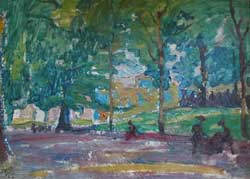
In Paris Dick Beer becomes an assiduous frequenter of the Colarossi academy and La Grande Chaumière. His series of pictures representing Notre Dame (oil, coloured pencil, watercolour) and painted in 1912 when he is only 19 are the works of an accomplished artist, counting among his best. There is nothing Swedish in these canvases, it’s impressionist in the great French tradition, it‘s Monet in more restrained colours. It is easy to believe that these pictures have been executed by one of the greatest on the continent, because apart from the sensitivity shown, the technique is perfectly mastered. In October 1913 he holds his first individual exhibition in Stockholm and the success is immediate. Beer is hailed as a hope of Swedish painting in its classic vein. We shall not forget, though, that impressionism, accepted in France as an established school around 1890 only acquired that status in Sweden in 1910 and that for market and recognition reasons there are few Swedish impressionists. Axel Gauffin, then the big name among Swedish art critics, takes Beer under his patronage. He reminds how little and how late impressionism has meant anything to Swedish painters:
“His technique is therefore something new for us, but is it because of this fact only that the art shown at his beautiful début exhibition seems so unexpected, beams as a radiant mirage in our autumnal mists and in the dust-clouds formed from the crumbling walls in the Svea Hall ? (…) In spite of all Beer’s youngish naïveté he knows so much, this debutant who overcomes all the difficulties of the air perspectives and the painting of light as if it were a child’s play.”
And Gauffin details in another long article (starting with the exclamation “At last a painter!”):
“For him art has its own existence touched by joy. With a fast and sensitive hand he puts his feelings on the canvas, distillates the weight of reality thanks to an impressionist technique equalizing the paint, with colour grains falling apparently in the instant, though coming to order with a surprising steadiness […] In these pictures, we are obviously plunged into French impressionism, but this is translated with a naïve frankness conferring something genuine to these airy visions with steel blue and violet imagined at Robinson or Fontenay aux Roses.
[…] It is hard to predict destinies. Many are called few are chosen. Nobody today can tell what will happen to Dick Beer. His art pertains to the present. But if the signs are not totally false, he may become a still greater artist.”
(Continued)